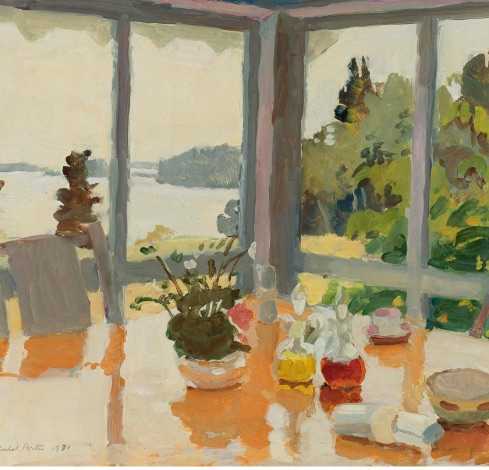Light and paint
I’m hardly posting here of late, because I’m finally hitting my stride again in the studio, after a desultory year, crammed with more social activity and other work than any year in recent memory–all of it good, but also a hindrance to daily painting. I have been almost completely abstaining from exhibiting work this year in an effort to get to the point I think I’m reaching now in my work, with strong momentum, along with a queue of ideas for enough future paintings to fill a show and a currently-successful diagonal move toward something a little different in my still lifes–while continuing to do what I’ve done before, alternating between the two modes. The perfectly executed painting by Porter, above, serves as something of an inspiration–most of the work he did at the end of his life (he had four years left when he painted this one) humbles me, actually, though what I’m doing isn’t nearly as loose. I may get there. What I’m trying to uphold from his example is the sense of a light-drenched scene, where color and only the upper register of values are used to define form, where the shape of the paint is as important as whatever the paint depicts, and where everything seems to have been laid down with a single brush, giving a unity to the marks. It’s as spontaneous as a watercolor, the liquid quality of the oil conveying the shine and reflections of the sunlight. It looks exactly right as you see it for the first time, until you wonder why the shadows of the porch’s window frames could be that yellowish-ochre-orange: in fact it’s the color of the table revealing itself in the shadows of those wooden struts, apparently beneath a sheet of glass laid down over it, or simply a glossy finish on the wooden tabletop. It appears Porter applied that color to the entire tabletop and then went back over it, alla prima, or else on the next day, with an off-white to convey the reflected light from outside. Maybe it’s just an arbitrary color choice that works because it evokes all of this even if he didn’t see it on the actual table. This one has an effortless quality, sprezzatura, the masterful way all the colors harmonize as an abstract pattern, and yet also, amazingly, evoke the unified world of that hazy day on the Maine coast, instantly recognizable as a moment of ordinary happiness, perfection. But it’s the quality of this light, coming from behind but also glowing in this porch, seemingly from all directions, that pushes me to take a different approach in the painting I’m doing now, not just in the quality of the scene, but in the way I’m applying the paint–a greater simplicity of application, thicker layers, some wet-on-wet, and a bolder more simplified way of building the picture through areas of color with less attention to minute details. I’m liking it.

Comments are currently closed.